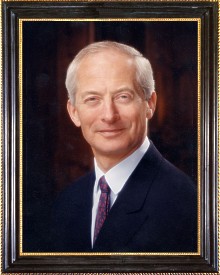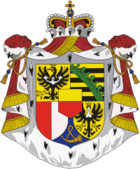

Liechtenstein

H.S.H. Prince Hans Adam II von und zu Liechtenstein
Seine Durchlaucht Fürst Hans-Adam II von und zu Liechtenstein
Reign: 13 November 1989 to Present
Grand Master of: Order of Merit of the Principality of Liechtenstein
Princely Coat of Arms  Princely Coat of Arms
Princely Coat of Arms

Castle Vaduz - Schloss Vaduz is the Princely Home
History
Archaeological findings prove that the territory of today’s Principality of Liechtenstein has been populated since the 5th millennium BC. Numerous places of worship and settlements were found in Gutenberg and Eschnerberg. The original inhabitants were considered to be Raetians, but also Celtic influences coming from the west can be found.
Raetia was conquered by the Romans and declared a Roman province in the year 15 BC. Already in the 1st century, a military road was build from Italy along the Splügen Pass, Chur and the Luziensteig on the right side of the Rhine valley towards Bregenz. In the 5th century, the Roman Empire began to decay. The centuries that followed were characterized by Alemannic immigration.
Beginning in the 10th century, Raetia belonged to the counts of Bregenz, who died out in 1152. The former Raetia was split up more and more by divisions of inheritances. At first, Lower Raetia was given to the counts of Montfort, who split up into the lines of Montfort and Werdenberg. The following centuries, the territory of Liechtenstein changed its occupant several times, until Prince Johann Adam Andreas of Liechtenstein drew his attention to the territory in question: The rules of Liechtenstein were elevated to the rank of princes in 1608, but this did not entail admittance to the Council of Princes. In order to obtain the admittance to the Council of Princes, they needed properties that enjoyed Imperial immediancy. Prince Johann Adam Andreas of Liechtenstein was able to purchase the Lordship of Schellenberg in 1699 and the County of Vaduz in 1712. Both dominions were elevated to the Imperial Principality of Liechtenstein in 1719.
The French Revolution constituted the beginning of far-reaching changes in Europe. Napoleon abolished the Old German Empire in 1806 and established the Rhine Confederation, in which Liechtenstein was admitted as a sovereign state. After Napoleon’s ultimate defeat at Waterloo, a new political order for Europe was negotiated at the Congress of Vienne in 1815. The independent small State of Liechtenstein was accepted into the German Confederation. In the long run, Liechtenstein became the only small German State able to maintain its independence.
In 1852, a Customs Treaty with Austria-Hungary was concluded. The first bank was opened in Liechtenstein in 1861; a reformist constitution was enacted and the first national newspaper was published in 1862. In 1918, the first political parties came into being: the Christian-Social People’s Party and the Progressive Citizens’ Party. Demands for a more democratic constitution ended in a new constitution in 1921, which provided significant direct democratic mechanisms (popular initiative and referendum).
Liechtenstein turned toward Switzerland after the collapse of the monarchy in Austria. In the year 1919, the Customs Treaty with Austria was terminated. An ever increasing network of treaties was concluded with Switzerland and the Swiss cantons over the following years and decades. The most important of these treaties is the Customs Treaty of 1923, which to this day forms the basis for a close partnership.
In 1938, Prince Franz Josef II to Liechtensetin became
the first Reigning Prince to establish his residence in Vaduz Castle. Since then
the acting Prince resides in the Principality of Liechtenstein.
The first new industrial establishments emerged already during the Second World
war. The years following the war were marked by an ongoing boom. Within only a
few decades, Liechtenstein developed from a poor agricultural state into a
modern society with a diversified economy. The highly specialized industrial
firms are competitive throughout the world, and trades occupy an important
position in the region.
After economic reconstruction in the postwar period, Liechtenstein joined the Statute of the International Court of Justice in 1950, signed the Helsinki Final Act of the CSCE (now OSCE) with 34 other States in 1975, joined the Council of Europe in 1978, and was admitted to the United Nations (UN) in 1990. Liechtenstein joined the European Free Trade Association (EFTA) as a full member in 1991 and has been a member of the European Economic Area (EEA) and the World Trade Organization (WTO) since 1995. From the perspective of economic and integration policy, Liechtenstein’s relations within the framework of the EEA and the EU play an important role in Liechtenstein foreign policy. In addition, the good relations with the neighboring countries of Switzerland and Austria are a particular priority.
Resources:
http://www.fuerstenhaus.li/en/fuerstenhaus/fuerstliche_familie/fuerst_hans-adam2.html
http://www.liechtenstein.li/en/eliechtenstein_main_sites/portal_fuerstentum_liechtenstein/fl-lik-liechtenstein_in_kuerze/fl-lik-geschichte.htm